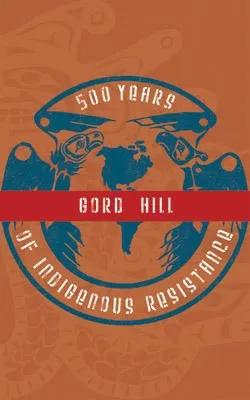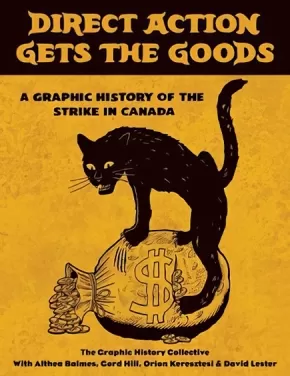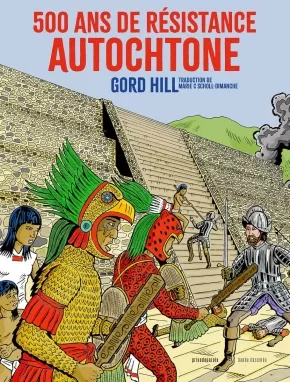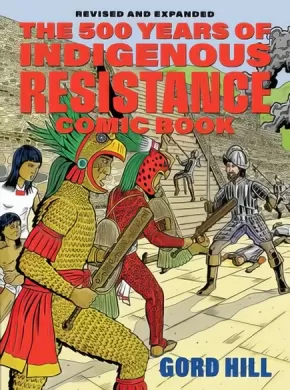
Gord Hill
Gord Hill is a member of the Kwakwaka'wakw nation whose territory is located on northern Vancouver Island and adjacent mainland in the province of "British Columbia." He has been involved in Indigenous people's and anti-globalization movements since 1990. He lives in British Columbia.
Books (2)
500 Years of Indigenous Resistance (PB)
$10.95
Format:
Paperback
Text Content Territories:
Indigenous American; Indigenous Canadian; Indigenous Central American; Indigenous South American;
Reading Level: N/A
ISBN / Barcode: 9781552663974
Synopsis:
Synopsis:
The history of the colonization of the Americas by Europeans is often portrayed as a mutually beneficial process, in which ”civilization” was brought to the Natives, who in return shared their land and cultures. A more critical history might present it as a genocide in which Indigenous peoples were helpless victims, overwhelmed by European military power. In reality, neither of these views is correct. This book is more than a history of European colonization of the Americas. In this slim volume, Gord Hill chronicles the resistance by Indigenous peoples, which limited and shaped the forms and extent of colonialism. This history encompasses North and South America, the development of nation-states and the resurgence of Indigenous resistance in the post-WW2 era.
Additional Information
72 pages | 8.50" x 5.50"
Direct Action Gets the Goods: A Graphic History of the Strike in Canada
$14.95
Format:
Paperback
Grade Levels: 12; University/College;
ISBN / Barcode: 9781771134170
Synopsis:
Synopsis:
Art has always played a significant role in the history of the labour movement. Songs, stories, poems, pamphlets, and comics, have inspired workers to take action against greedy bosses and helped shape ideas of a more equal world. They also help fan the flames of discontent. Radical social change doesn’t come without radical art. It would be impossible to think about labour unrest without its iconic songs like “Solidarity Forever” or its cartoons like Ernest Riebe’s creation, Mr. Block.
In this vein, The Graphic History Collective has created an illustrated chronicle of the strike—the organized withdrawal of labour power—in Canada. For centuries, workers in Canada—Indigenous and non-Indigenous, union and non-union, men and women—have used the strike as a powerful tool, not just for better wages, but also for growing working-class power. This lively comic book will inspire new generations to learn more about labour and working-class history and the power of solidarity.
Reviews
"There are so many exciting and vitally important stories from the history of social movements, and the most engaging way to tell those stories is through art, in its various forms. The Graphic History Collective is brilliantly doing just that." - David Rovics, singer, songwriter, activists
"The Graphic History Collective shows us that art can inspire hope for radical social change" - Noam Chomsky
"Brilliant in narrative power and artistic expression, Direct Action Gets the Goods offers more proof of the Graphic History Collective's prowess with the graphic form. Magnificent!" - Paul Buhle
"Direct Action Gets the Goods is a brilliant and essential resource. Through well-researched history and powerful graphic art, it shows how the strike is key to revolutionary unionism and social movement solidarity. This book will inspire future generations to fight and win against bosses and capitalism." – Harsha Walia, community organizer and author of Undoing Border Imperialism
Educator Information
The Graphic History Collective is made up of activists, artists, writers, and researchers passionate about comics, history, and social change. They produce alternative histories - people's histories - in an accessible format to help people understand the historical roots of contemporary social issues.
Additional Information
64 pages | 8.50" x 11.00" | 80 illustrations
Authenticity and Content Note: This work contains contributions from Gord Hill, a member of the Kwakwaka'wakw Nation. Indigenous content and perspectives, therefore, may be included but are not the sole focus of the work.
Teen Books (3)
500 ans de résistance autochtone
$29.95
Artists:
Format:
Paperback
Text Content Territories:
Indigenous American; Indigenous Canadian; Indigenous Central American; Indigenous South American;
ISBN / Barcode: 9782897443955
Synopsis:
Synopsis:
Avec un langage fort et des illustrations évocatrices, cette bande dessinée – fruit des nombreuses années de recherche, de création et de militantisme de son auteur – révèle la ténacité et la persévérance des Premiers Peuples qui luttent depuis 500 ans contre les massacres, les déplacements et l’assimilation. Antidote nécessaire à l’histoire officielle des Amériques, elle présente sous un nouveau jour des événements marquants comme la conquête espagnole des empires aztèque, maya et inca, la révolte des Pueblos de 1680 au Nouveau-Mexique, la bataille de Wounded Knee en 1890, la résistance des peuples des grandes Plaines au 19e siècle, et plus récemment, les manifestations Idle No More de 2012-2013 en défense de la souveraineté et des droits autochtones, et la résistance au Dakota Access Pipeline de 2016. Au Canada, elle aborde la crise d’Oka de 1990, le conflit foncier de Grand River entre les Six Nations et le gouvernement fédéral de 2006 et les manifestations anti-pipeline des Wet’suwet’en de 2020. Parue en langue originale anglaise chez Arsenal Pulp Press en 2010, cette œuvre unique en son genre a connu un énorme succès populaire (10?000 exemplaires vendus) et critique. Colorisée, revue et augmentée en 2021, la nouvelle édition – présentée ici en traduction – inclut les résistances autochtones les plus récentes. Elle comprend une préface de Pamela Palmater, avocate, professeure et commentatrice politique mi’kmaw.
Educator Information
This book is available in English: The 500 Years of Indigenous Resistance Comic Book: Revised and Expanded
The 500 Years of Indigenous Resistance Comic Book: Revised and Expanded
$21.95
Artists:
Format:
Paperback
Text Content Territories:
Indigenous American; Indigenous Canadian; Indigenous Central American; Indigenous South American;
ISBN / Barcode: 9781551528526
Synopsis:
Synopsis:
A new and expanded version of Gord Hill's seminal illustrated history of Indigenous struggles in the Americas. When it was first published in 2010, The 500 Years of Resistance Comic Book was heralded as a groundbreaking illustrated history of Indigenous activism and resistance in the Americas over the previous 500 years, from contact to present day. Eleven years later, author and artist Gord Hill has revised and expanded the book, which is now available in colour for the first time.
The 500 Years of Indigenous Resistance Comic Book powerfully portrays flashpoints in history when Indigenous peoples have risen up and fought back against colonizers and other oppressors. Events depicted include the the Spanish conquest of the Aztec, Mayan and Inca empires; the 1680 Pueblo Revolt in New Mexico; the Battle of Wounded Knee in 1890; the resistance of the Great Plains peoples in the 19th century; and more recently, the Idle No More protests supporting Indigenous sovereignty and rights in 2012 and 2013, and the resistance to the Dakota Access Pipeline in 2016. Canadian events depicted include the Oka crisis in 1990, the Grand River land dispute between Six Nations and the Government of Canada in 2006, and the Wet'suwet'en anti-pipeline protests in 2020.
With strong, plain language and evocative illustrations, this revised and expanded edition of The 500 Years of Indigenous Resistance Comic Book reveals the tenacity and perseverance of Indigenous peoples as they endured 500-plus years of genocide, massacre, torture, rape, displacement, and assimilation: a necessary antidote to conventional histories of the Americas.
The book includes a foreword by Pamela Palmater, a Mi'kmaq lawyer, professor, and political commentator.
Reviews
"Gord Hill's goal of giving indigenous peoples a better understanding of their past so as to counter the benign version all too often taught in schools and presented in the media makes the format [of his work] the perfect vehicle for his hard-hitting message."-BC Studies
"Gord Hill has put colonial myth-makers on notice with a comic that educates and inspires." - The St'at'imc Runner
"Comics aren't always known for treating serious subjects, but Gord Hill's The 500 Years of Resistance Comic Book adds a dose of reality to the genre. Hill, of the Kwakwaka'wakw nation, has taken the topics of dispossession, genocide, and the colonization of First Nations in the western hemisphere and, surprisingly, pulled off a rendering in comic book form." -Dissident Voice
"Never before have I come across a non-fiction graphic novel capable of evoking such a powerful emotional response. Dealing with such topics as genocide, oppression and assimilation the comic is sure to cause frustration and sadness in the reader. At the same time, 500 Years of Resistance is inspirational and empowering, accurately depicting the strength and nobility of Native warriors. Gord's straightforward approach to writing coupled with his iconic illustrations has created a truly groundbreaking comic book." -Redwire Media
"An excellent introduction to the tremendous historical and ongoing legacy of resistance on the part of Indigenous peoples in Canada and elsewhere in the continent against the settler colonial regimes that continue to oppress and exploit." -Popmatters. com
Educator Information
This book is available in French: 500 ans de résistance autochtone
Additional Information
144 pages | 9.00" x 12.00" | Comic Book | Colour Illustrations Throughout
The Antifa Comic Book: 100 Years of Fascism and Antifa Movements
$21.95
Format:
Paperback
ISBN / Barcode: 9781551527338
Synopsis:
Synopsis:
The shocking images of neo-Nazis marching in Charlottesville, Virginia, in the summer of 2017 linger, but so do those of the passionate anti-fascist protestors who risked their lives to do the right thing. In this stirring graphic non-fiction book by the author of The 500 Years of Resistance Comic Book, Gord Hill looks at the history of fascism over the last 100 years, and the concurrent antifa movements that have worked fastidiously to topple it.
Fascism is a relatively new political ideology, yet in its short history some of the greatest atrocities against humanity have been carried out in its name. Its poisonous roots have taken hold in every region of the world, from its beginnings in post-World War I Italy, through Nazi Germany, Franco's Spain, and the KKK in America. And today, emboldened by the American president, fascism is alive and well again. At the same time, antifa activists have proven, throughout history and again today, that the spirit of resistance is alive and well, and necessary.
In The Antifa Comic Book, Gord Hill documents these powerful moments of conflict and confrontation with a perceptive eye and a powerful sense of resolve.
Full-colour throughout. Includes a foreword by Mark Bray, author of Antifa: The Anti-Fascist Handbook.
Additional Information
112 pages | 8.00" x 10.00"











